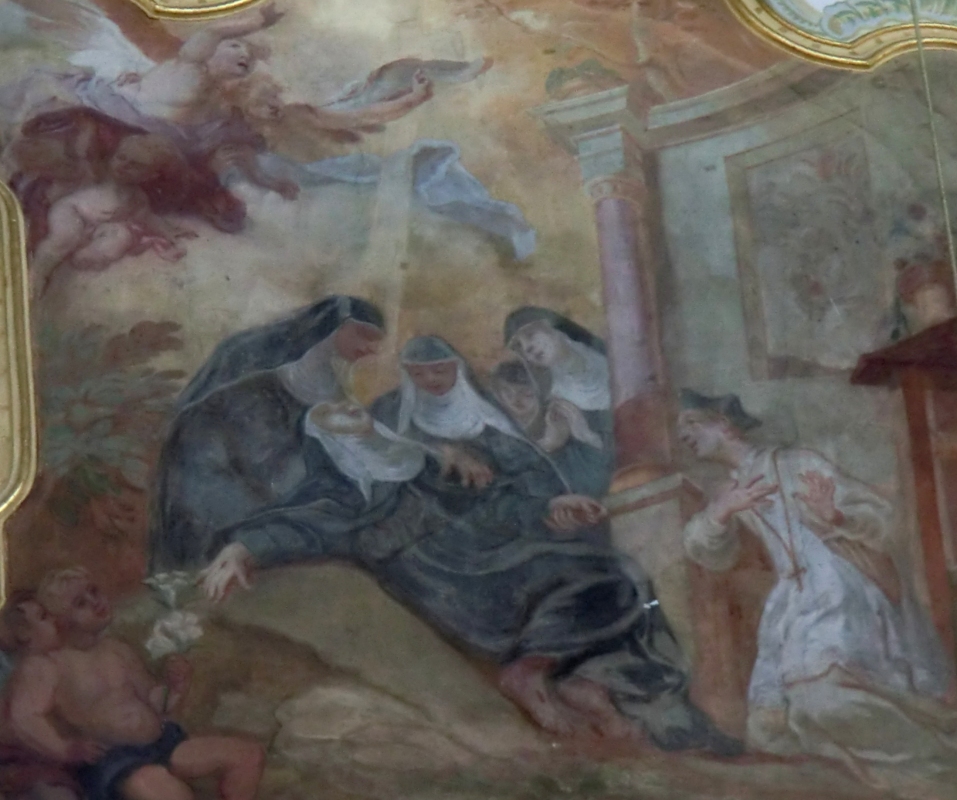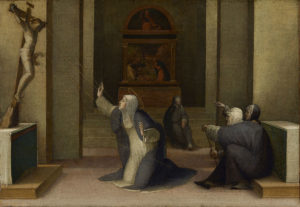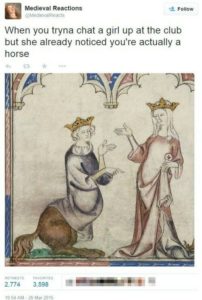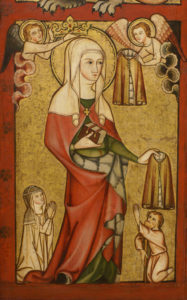Vernacular religious literature from fifteenth-century Germany is not known for being eloquent, creative, or interesting. When I proposed a dissertation topic that heavily involved the era’s didactic literature, one of the members of my committee responded, “Are you sure you want to do that?”
Yet fifteenth-century Germans produced more vernacular literature than any other time or place in the Middle Ages, and scholars estimate seventy to eighty percent of it was religious. [1] These books, however lacking in literary splendor, were wildly popular both to read and to write; they survive from clerical and lay libraries alike.
The context adds one more layer to the interesting (really!) German hagiography of Elisabeth Achler von Reute (1386-1420), written by her confessor Konrad Kügelin. Kügelin wins no prizes for his prosecraft, to be sure. He makes up for it with his ebulent enthusiasm for Achler’s sanctity and his obvious concern for her as a person. But most of all, he makes up for it through the often colorful stories he spins out of what was apparently a quiet and peaceful cloistered life.

Achler was a sister in a convent founded by Augustinian friar Kügelin and loosely affiliated with the Franciscan Order. As her Leben shows, she spent most of her adult life struggling to fit the mold of a late medieval holy woman. Above all, that mantle meant self starvation. Achler was either a star or a fraud—depending on whether you asked Kügelin or asked his portrayal of the convent’s other sisters.
Kügelin insists upon their suspicion (argwon) of Achler’s supposed miraculous inedia again and again through the Leben. He’s not reticent about the reason for the emphasis: it demonstrates Achler’s Christ-like forebearance in the face of persecution. Here, I’m going to look at two episodes depicting the sisters’ suspicion.
The first one is actually pretty cute, or at least, it would be cute if it weren’t so sad. One day, the sister assigned to the kitchen sets up to cook several pieces of meat. But when it’s time to eat, there are only two pieces left. When one sister wonders aloud where the meat went, the cook answers, “Oh, where all the other things must go—our cat with two legs must have taken it.” [2]

The “cat with two legs” story is short and almost sweet, even if Kügelin was attempting to portray the sisters’ suspicion instead of their support for Achler’s efforts at sanctity. A second anecdote could likewise be spun as suspicion or concern. Realizing that Achler hasn’t been eating, one sister goes off to the town of Reute to buy “little fishes” that hopefully she will like. Achler dutifully eats them—demonstrating her adherence to monastic obedience, of course. But she almost immediately throws them back up, not even slightly digested. [3]
In both cases, Kügelin’s presentation of events can be read as suspicious sisters setting a deliberate trap with simmering meat on the stove or specially-purchased fish, or as concerned sisters desperately trying to get Achler to eat something. Rather than unravel that mystery, I’m going to take a more basic approach: Kügelin’s presentation of events can be read in the first place.

Kügelin wrote numerous drafts of Achler’s Leben, which survive in multiple manuscripts. Their relationship was examined by Karl Bihlmeyer in 1932, who showed that the cat with two legs story and the little fishes episode are both new to one of the revisions. In the oldest version, the two anecdotes have only a faint presence. Regarding the first, Kügelin notes that some beans and lentils went missing from the kitchen. That’s the beginning and end of the “action” in a long paragraph emphasizing suspicion. No simmering meat, no cute comments. In the little fishes story, similarly, there are no trips to town and no little fishes. Achler eats something one day and promptly throws it up. [4]
Thus, Kügelin added or embellished stories from the likely first to the likely second drafts of Achler’s Leben.
As a modern reader, I appreciate this development. As a scholar who told her concerned committee member, “Yes, I’m sure,” I also appreciate that Kügelin went against contemporary trends when he increased the entertainment value of the hagiography. He did the equivalent of writing out his sermons with great exempla already woven in.
Unfortunately and unfairly, I have to leave you—and more to the point, me—without a snappy conclusion regarding why Kügelin believed these later additions would strengthen the case for Achler’s sainthood. But look on the bright side. Two different versions of Achler’s hagiography have been in print since 1881 and 1932. What better time to start comparing them than 2020?
Cait Stevenson
PhD in History
University of Notre Dame
—
[1] See, for example, Karl Ruh, “Geistliche Prosa,” in Europäisches Spätmittelalter, ed. Willi Ergräber, Neues Handbuch der Literaturwissenschaft 8 (Akademie Verlagsgesellschaft Athenaion, 1980), 565; Werner Williams-Krapp, “The Erosion of a Monopoly: German Religious LIterature in the Fifteenth Century,” in The Vernacular Spirit: Essays on Medieval Religious Litearture, ed. Renate Blumenfeld-Kosinski, Duncan Robertson, and Nancy Bradley Warren (Palgrave, 2002), 239.
[2] Anton Birlinger, ed., “Leben heiliger alemannischer Frauen I: Elisabeta Bona von Reute,” Zeitschrift für Sprache, Litteratur, und Volkskunde des Elsasses, Oberrheins und Schwabens 9 (1881): 280.
[3] Birlinger, 281.
[4] Karl Bihlmeyer, ed., “Die Schwäbishe Mystikerin Elsbeth Achler von Reute (d. 1420) und die Überlieferung dihrer Vita,” in Festgabe Philipp Strauch zum 80. Geburtstage am 23. September 1932, ed. Georg Baesecke and Ferdinand Joseph Schneider (Max Niemeyer Verlag, 1932), 101-102.



 We’ve all seen the “I take 1000 selfies for every one I can post” Instagram admissions, and the smartphone videos where the gorgeous YouTube star turns this way and that to display how she can go from (ridiculously thin and good-looking) normal to supermodel quality with angles and makeup. These social media accounts have a rhetoric of their own. The “Feet in the foreground, beautiful scenery in the background” photo means ultimate relaxation. Twitter has its own grammar, often departing from “proper” English, that mashes up different vernaculars and changes from meme to meme.
We’ve all seen the “I take 1000 selfies for every one I can post” Instagram admissions, and the smartphone videos where the gorgeous YouTube star turns this way and that to display how she can go from (ridiculously thin and good-looking) normal to supermodel quality with angles and makeup. These social media accounts have a rhetoric of their own. The “Feet in the foreground, beautiful scenery in the background” photo means ultimate relaxation. Twitter has its own grammar, often departing from “proper” English, that mashes up different vernaculars and changes from meme to meme. The fifteenth-century hagiography of Elisabeth Achler, a Franciscan tertiary from Reute, ascribes to her the standard catalogue of proper saintly elements. She could almost be the exemplar of a late medieval holy woman. But her hagiographer, Augustinian prior Konrad Kügelin, does not stop with standard recitations of virtues and somatic spirituality. In almost every category, Achler is said to exceed even the most frenetic reports of her role models’ own deeds.
The fifteenth-century hagiography of Elisabeth Achler, a Franciscan tertiary from Reute, ascribes to her the standard catalogue of proper saintly elements. She could almost be the exemplar of a late medieval holy woman. But her hagiographer, Augustinian prior Konrad Kügelin, does not stop with standard recitations of virtues and somatic spirituality. In almost every category, Achler is said to exceed even the most frenetic reports of her role models’ own deeds.